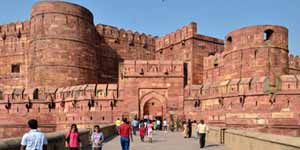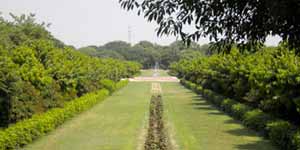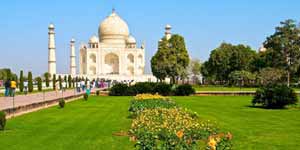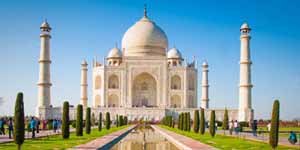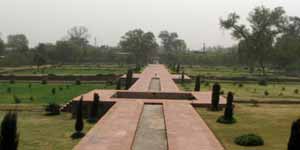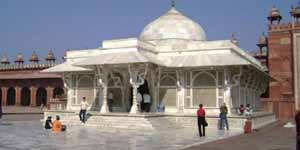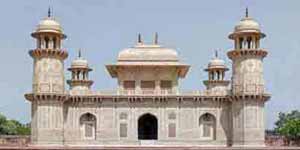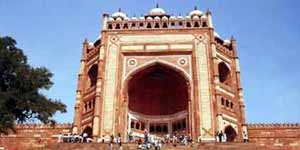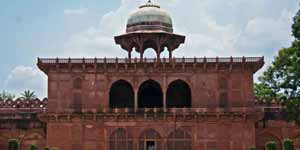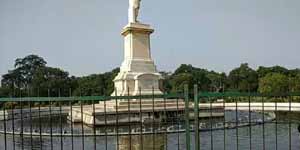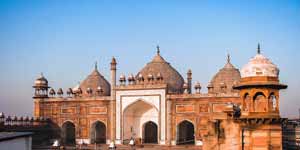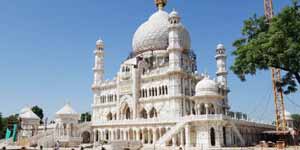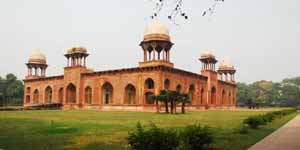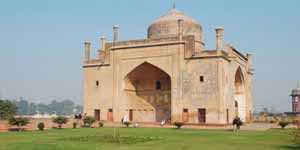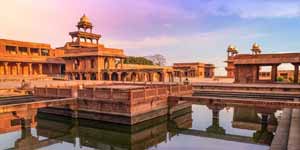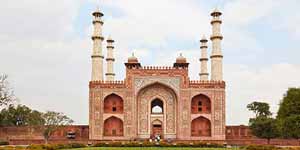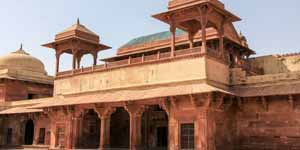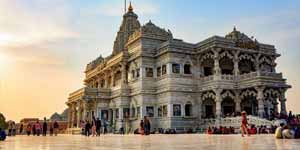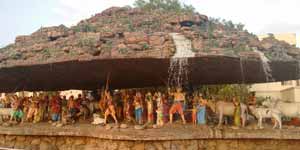

Sikandra Akbars Tomb at SikandraAkbar started building his own mausoleum, near Agra, that was to be a perfect blend of Hindu, Christian, Islamic, Buddhist and Jain designs and motifs, bespeaking of his religious tolerance and secular views. However, he could not complete it and died. Thus, his son Jehangir completed his tomb, popularly known as Sikandra after Sikandra Lodi, who established the community where Akbar's Tomb is located. However, Jehangir made quite a number of alterations in the original plan, in keeping with the development of Mughal art and architecture. The tomb has three-storeyed red sandstone minarets displaying wondrous inlay work of marble on the four corners of the building. 'Langurs', black-faced monkeys have found a safe haven in the beautiful gardens surrounding the mausoleum and often stray to the walkways too.
One can see the Baradi palace in the gardens built by Sikander Lodhi. The tomb building is shaped like a truncated pyramid and has five storeys while the main tomb has a distinct square design. There are spacious cloisters on the ground floor. An elaborately decorated vestibule occupies the centre of the southern side, highlighted by exquisite carvings, artistic paintings and inlay work in geometric and floral designs enshrining the tombstone of Akbar. Other tombs on this floor belong to Shakrul Nisha Begum and Aram Bano, the daughters of Akbar. The ornamental arch and square pillar on the second storey looks unique. The third and fourth storeys also have identical arrangement of arches supported on pillars and chhatris adorning the façades. All the storeys are built in red stone except the fifth one, which is entirely in white marble.
History
The tomb of Akbar was built by his son prince Salim also called Jahangir. Akbar planned the tomb and selected a suitable site for it. After his death, Akbar's son Jahangir completed the construction in 1605-1613.
Akbar was one of the greatest emperors in the history of India. However, during the reign of His great-grandson, Aurangzeb, the rebellious Jats under the leadership of Raja Ram Jat, ransacked the intricate tomb, plundered and looted all the beautiful gold, jewels, silver and carpets, whilst destroying other things. He even, in order to avenge his father Gokula's death, plundered Akbar's tomb, looted it and dragged Akbar's bones and burned them in retaliation. He was later sentenced to death by Aurangzeb.
The Tomb has suffered a lot, until extensive repair was carried out by the British under Lord Curzon. The neighbouring Taj Mahal was also looted, and two of Agra's gates were taken away.
Architecture of Akbar's Tomb
The tomb of Akbar is done in typical style and symmetry of various monuments during the Mughal era. This monument is the perfect symbol of Mughal architecture. However, there are also features of Rajputana and Gothic style of architecture. It has four minarets similar to the Taj Mahal's minarets, at the largest gate. The southern gate is the largest of the four gates of this tomb and is the general gate for entry. There are total of four storeys and it is enclosed within a large wall around the tomb.
The marble pavilion hosts the fake tomb and the real tomb is situated inside the basement of the monument. It is surrounded by walkways on all sides but there is no walkway on the center of southern gate main entrance. There are arcades and arches along side the walkways that make them into bays. The following three storeys are square in shape with kiosks on their side. The second storey has marble roof and gets into the shape of a pyramid. The final top part are Chhatri – shaped crown cupolas.
The main construction material used for the building structure is deep red sandstone mixed with marble. The inlay panels are done with black slate at the main gatehouse and across the monument. There are designs, calligraphy, floral patterns, and geometrical designs found on the panel inlays. The top most floor is a pavilion made completely from white marble stone and is like a square court. The central courtyard is covered by lovely arches. The central courtyard is a square platform in marble where the false tomb with floral designs carvings.
It has the Charbagh system of garden with water canal dividing it by four sections. The tomb of Akbar monument also has the remains of his daughters laid here.
